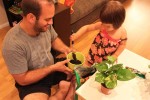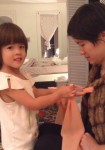Being the Youngest Child In a Montessori Class
For the last two weeks, I’ve been observing in a classroom at a Montessori school.
As a student, consultant and teacher-to-be, I learned a tremendous amount watching these 30 children between 2.5-6 years old. As a parent with two children just starting Montessori school, it was a revelation.
B and M started school six weeks ago (they attend a different school than the one I observed at). They are the youngest in their class of 25 children. Until now, I’ve spent nearly every moment of their lives with them. Suddenly, they are gone for so many hours. I often wonder if they are too young to be in school for this long. My biggest worry came three weeks after school started, when they started getting extra clingy and needy at home. Even M, who was usually independent, started throwing herself on the floor and whining because she wanted me to pour the milk for her. That was unusual.
I got some clue to what was happening when I started observing Jackson, the newest 3-year-old in the class. Watching him helped me realize what happens with young children in a mixed-age classroom: the older children love taking care of them. They don’t crowd them like adults do, but if the little ones show any sign of hesitation, the older ones will swoop in like little super-heroes and help. For a second, I thought maybe it wasn’t a good idea to have my children surrounded by so many older children, who were getting in the way of their independence…until I spent two hours observing what else Jackson was experiencing.
Jackson’s Day
The day starts with Jackson doing some knobbed puzzles (also known as cylinder blocks), which the teacher had shown him a couple days ago. He puts it back on the shelf and starts roaming around the room.
He stops to watch 5-year-old Artie make bread, measuring out ingredients, pouring them into a bowl then kneading them with his hands. While the dough is rising, Artie starts cleaning. He gets the table crumber (a small dustpan and broom for the table). Jackson follows and gets the second table crumber. Artie starts sweeping and Jackson imitates him. Artie then fetches the dustpan and broom for the floor. Jackson does the same thing. Just as Jackson was about to sweep the table again, Artie says, “That’s for the floors. The crumber is for the table.” 3 year old’s aren’t always expressive, but I could’ve sworn a lightbulb went off.
As Artie is waiting for the dough to rise, Jackson watches him do math for a bit, then decides to get snack – bananas, carrots and raisins in a box. He sits down to eat the raisins, but cannot get to the last couple. Olivia, a 4-year-old girl, goes over to help him take out the last couple. I don’t know how she noticed, but she did!
Olivia sits down at her own table to do gluing. He finishes snack and comes to observe her. Music comes on for Walking On the Line. That’s a special Montessori activity where the teacher plays different kinds of music, and the children who participate can walk, skip, march, run or walk sideways along a line on the floor. The marching song comes on.
Olivia: “That’s the music for Walking On the Line.”
Jackson: “Yeah, you stomp.”
Olivia: “Yeah, that’s the marching music.”
Jackson: “Marching?”
Jackson starts marching in place. The next song comes on.
Jackson: “What’s that?”
Olivia: “That’s the song for running.”
Jackson: “The running song? Like this?”
Jackson starts running in place. They laugh. It was a funny moment only children understand.
Later, another four-year-old, Anna, walks with him around the shelves pointing out the different activities: “You can open these (containers). This is bead stringing. You sit in this chair to comb your hair. This is the Russian doll. You need a mat to do this.” And then she goes to fetch a mat, rolls it out at a table and shows him how to take out each of the Russian dolls and how to put them back.
A little while later, he goes to watch the teacher give four-year-old Henry a spelling lesson with the alphabet box. He watches as Henry spells ‘cat,’ ‘dad,’ ‘bird,’ ‘horse’, etc. – 11 words in total.
All of this was followed by a birthday celebration for a 6-year-old complete with astronomy (how it takes one year for the earth to move around the sun), story-telling, poetry and song.
In two short hours, I observed Jackson immersed in an environment with way more information than any adult could teach him. And with his ‘Absorbent Mind,’ he took it all in: from math, to spelling, to the procedures of making bread, to music, to art, to all the different activities available in the classroom, not to mention all the different children he interacted with. He experienced many activities he could do now and many others that were just 2 or 3 steps away from where he’s at now. This environment was rich, meaningful and, dare I say, perfect, for the development of this child. With all my training, even if I could do the same activities at home, I could not give them the richness that comes with all these mixed-age children.
This morning, I dropped off B and M at school. I looked inside their classroom and saw these things: the same Montessori materials, equally well-trained teachers and 25 other children of varying ages. I breathed a sigh of relief. They’re getting a great education here and I could go off feeling relaxed and happy.
Epilogue
I just came back from parent-teacher conference and found out that B and M do not whine at school at all. They are very independent and want to do everything themselves. So it’s just with Mom…*sigh*. The teacher, whose class I observed, was an incredibly patient human being, and I’ve been channeling her every day when necessary. I go back to the principles of Connection Before Correction, the 3 stages of obedience and general deep breaths. I’m not perfect, but I’m trying!
*Interested in setting up the perfect Montessori home environment for your little one(s)? Click here to find out more about my Private Consultation Services.
**All the names of the children mentioned in this article have been changed











